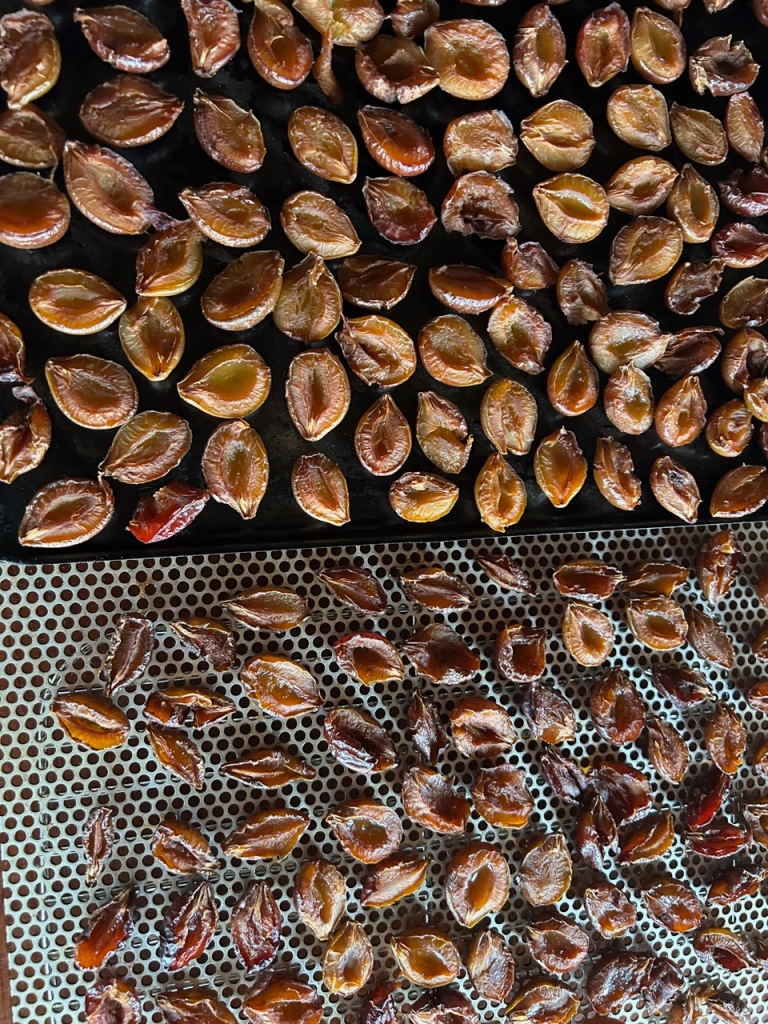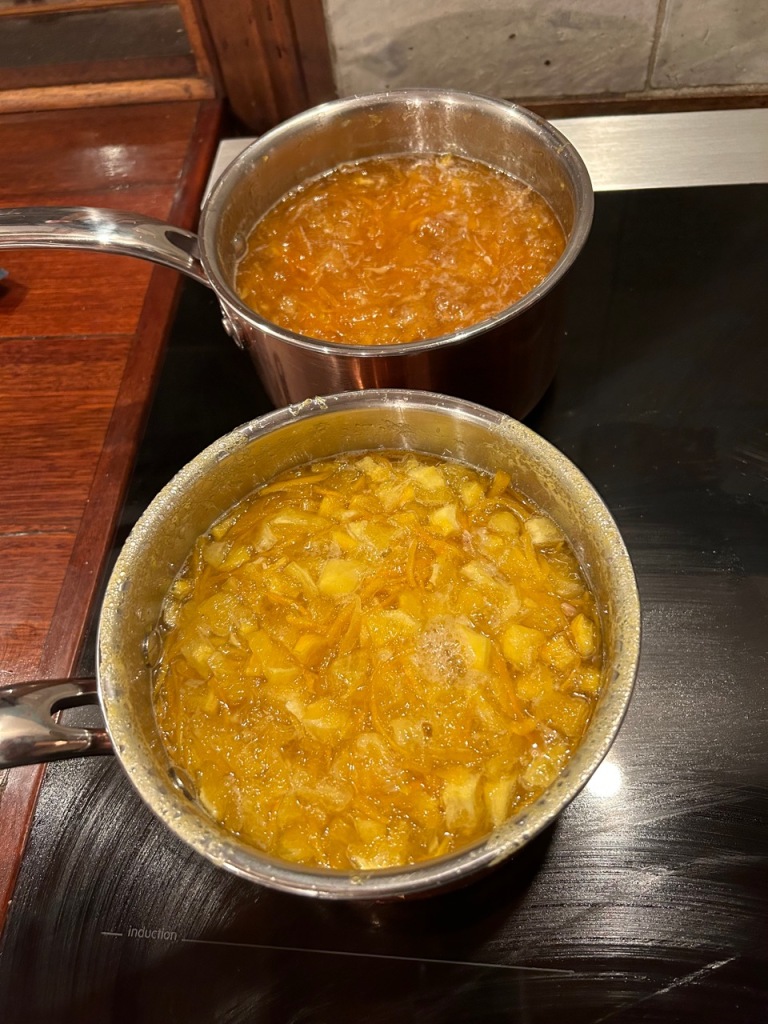Janine and I have been kept very busy dealing with all the summer produce from the garden and orchards. Nothing new there. We’ve been doing it for almost 50 years. But this last few years/summers, have been hot and wet, so everything has grown it’s head off. It’s a lot to keep up with. Especially as we age and find it harder to drum up the energy. The intention and enthusiasm is still strong, so we need to find ways of working smarter.



I cooked up a few early hard pears from the orchard in some red wine with a spoon full of sugar and a fragment of cinnamon bark, then laid them into an almond flan. Pretty yummy for morning tea. This is one of the best reason why we garden! So that we can eat amazing, wholesome, natural, un-sprayed fruit flans.
We had the organic gardening group here last weekend to help is with several gardening jobs around the property.
I spent a few hours picking citrus stink bugs off the citrus trees with the assistance of our friend Helen from the group We half filled a bucket with the little buggers.

A bucket half full of stink bugs in a solution of detergent and bleach.
There are 16 trees in the citrus grove, so it took a while. I also pruned off a lot of the taller branches from the bigger trees, to keep them within standing reach. I’m too old to climb ladders now – unless I really need to.
I picked all the prunes of the d’Agen tree and filled a 1/3 of a bucket. I cut them in half and semi-dried them in the oven. It took a couple of sessions. I made a cottage cheese and prune tart with some of them and bottled the rest in brandy for a similar use later in the year.









While climbing through the spiky branches of some of the citrus trees, looking for bugs and sniping off tall shoots. I managed to tear my ancient gardening straw hat and hanky combo to shreds. This hat and even older hanky (which was bright fire-engine red in its youth) was my ‘legionnaires’ head and neck shade when working outside The straw hat was 2nd hand about 7 yeas ago, so has earned its keep. I decided that it was past repair now, having seen so many summers of use, and it was 2nd hand to begin with, so I composted it!
I splurged and bought a brand new ‘ear-muffler-compatible’ work hat and added another one of my very old hankies as a neck shade. I recycled our son Geordie’s old nappy safety pins off the old hat. Re-purpose, re-use, and re-cycle. In fact, something old, something new, something repurposed, something blue. A true marriage of convenience. Those nappy pins have served us well, as our son is 40 years old now! If I keep them long enough, they can work just as hard on their last job, keeping my incontinence nappies in place in another 10 or 15 years when I become senile?


Our visiting organic gardener friends did some weeding and pruning in the veggie garden, and a few of them harvested all the fallen hazelnuts from under the trees so that we can get in there and mow the long grass. They also pruned off all the vigorous extraneous shoots from their bases. Hazels want to become dense hedges. It’s their nature. Up until the fire in 2019, we had cut them all back to just one main leading shoot and stem or trunk. But after the fire, they were burnt to ground level, so had to regrow from scratch. We were too busy rebuilding to worry about pruning the hazels. I was just glad to see them regrow. When I get the time??? – if ever, I’ll get stuck in there and cut them back to just one leader.


The petrol powered, ride-on mower, has broken two drive belts in two weeks. These modern belts seem to last only 8 to 9 years these days. It took several days to get them ordered in and fitted on each occasion, so the grass had grown very high and lush in its absence.
We have just completed a further step in our drive to go completely solar electric. I bought an electric ride-on mower. I have only had it for one day so far, and it did some pretty heavy mowing through dense grass. I got 1 hr, 20 mins of mowing out of the battery, ( that’s enough on a hot day) and almost completed all the ‘tame’ flat lawn around the house. I’ll report back in a month or so and give a follow-up on its performance. We now have a solar electric ride-on, push mower, strimmer, and chainsaw.


I haven’t given any up-date on our plug-in electric hybrid car recently. Nothing to report. It has just had its 5th year service, and has exceeded our expectations. It works perfectly. It does everything that we need and ask of it. We occasionally have to put some petrol in the fuel tank. About $20 to $30 every quarter, as it is a plug-in hybrid. But for the most part, we drive 90/95% of the time on our own solar roof top electricity. It was a perfect choice for us. I’m so glad that we did it when we did. This model is no longer available. They are all fully electric now and cost twice as much! Our early adoption of solar electric driving has proved to be a good decision.
We have been having 30oC days recently, so in the heat of the day, when it is too hot to be outside in the garden. I spend a few hours in the pottery, continuing with the sgraffito work that we started, inspired by Warren Hogden a couple of months ago. All the early work on tiles and square plates made at Warren and Janine’s weekend workshop, were all fired at cone 6, 1200 oC.

All the work that I have been making since then is all sericite porcelain, so I’m hoping that there will be a nice graphic interface with the light shining through the translucent porcelain body from the inside, creating a lovely glow, and vice versa.





I’m really enjoying it. It’s a lot of fun, and such a change for me.













































































































You must be logged in to post a comment.